Configuration of storage devices
This section describes some general aspects of the planned features for Agama regarding storage setup and shows how the web interface can be used to configure the related settings.
Since the interface is in constant evolution, the screenshots may not be a faithfull representation of the current look & feel.
The general approach
Agama uses the same algorithm and similar configurations for both interactive and unattended installations, combining capabilities of the traditional YaST proposal (usually known as Guided Setup) and the AutoYaST profile. Those configurations can be specified using the web interface or through a JSON-based configuration profile.
Agama can work with very detailed descriptions on how the storage setup must look like, analogous to the specifications produced by YaST's Expert Partitioner or the AutoYaST profile which both include every single detail about partitions, file systems or LVM structures.
On the other hand, Agama can automatically determine any omitted aspect of the configuration, based on the definition of the operating system to install ("product" in Agama jargon) and the properties of the system, without the user specifying, or even understanding, every single configuration option.
That opens the door for configurations with any level of detail. For example, the user can use the web interface to specify the creation of a root ("/") file system and a swap space, with no further information. Agama would then infer all the details of the file systems (like the type, the mount parameters, usage of Btrfs snapshots...) and would calculate appropriate sizes for the associated partitions. The user can decide at any point to override any of the automatic values (eg. specifying a size range for a partition) or to go back to the automatic mode for that particular setting.
Something similar happens with complex structures like LVM, that can be specified in a quite loosely way, as explained below.
Overall description of the Storage page
Agama does not offer a direct replacement for the YaST Expert Partitioner. Although creating such a tool is not discarded for the future, the Agama web interface should be enough to cover most of the Expert Partitioner capabilities. In many cases, even in a more convenient way.
The Storage section of the Agama web interface presents both the installer settings and the planned result of applying those settings to the current system.
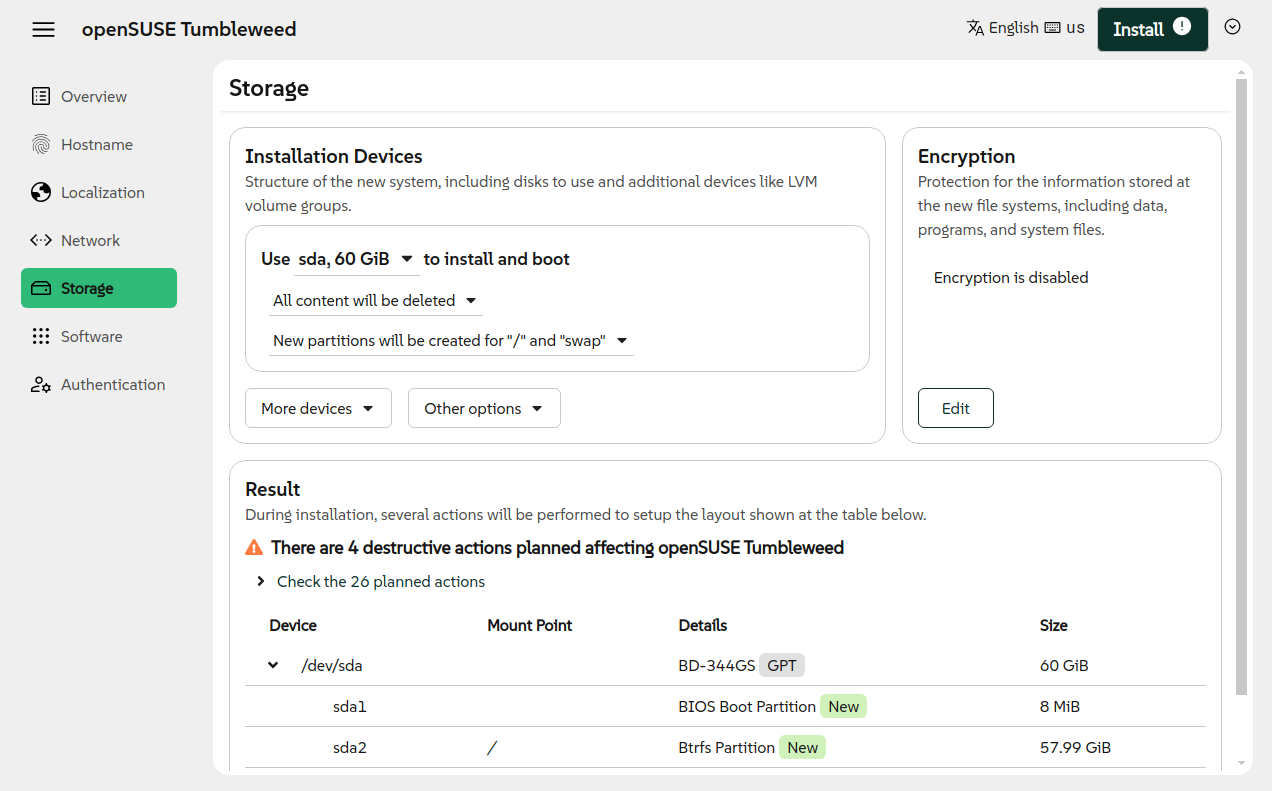
The configuration defines which devices to use and how, which new logical devices to create (eg. LVM) and where to allocate (or reuse) the file systems of the new operating system. The result is currenty represented as a list of planned actions and a table representing the final state of the affected devices. In the long term, a better alternative to show the result could be developed.
Every change to any of the configuration options will result in an immediate re-calculation of the section that presents the result. As already mentioned, the configuration options are identical to the case of unattended installation (see detailed description at the corresponding section), although the user interface presents more clearly the relationship between those settings and the system being used for installation.
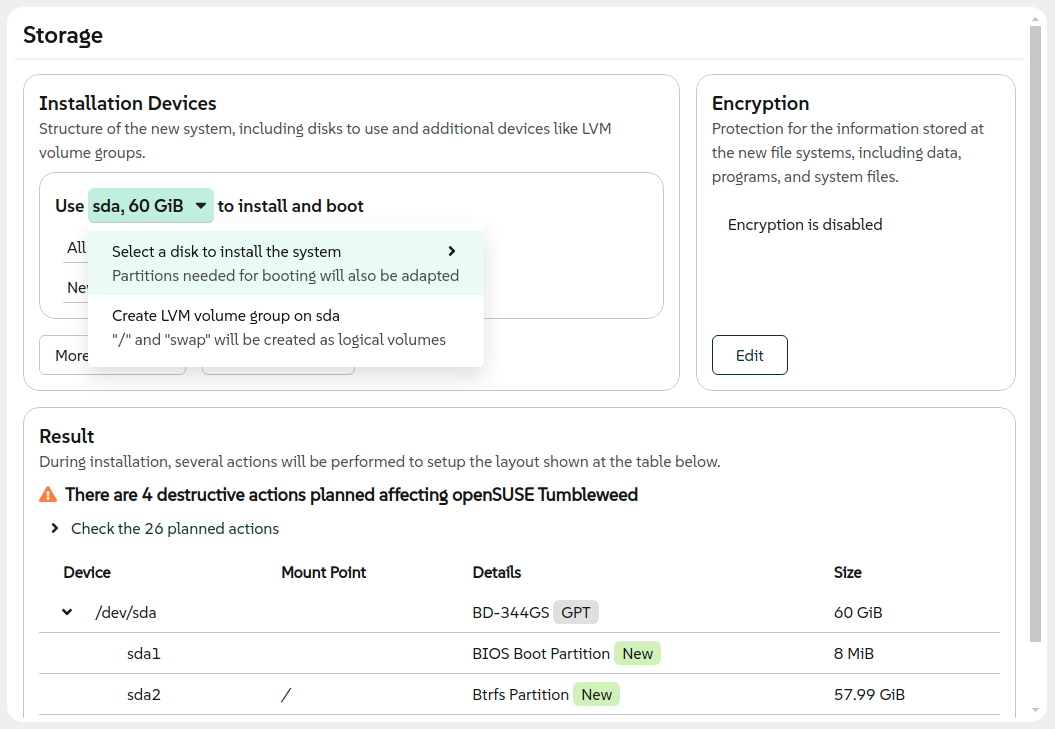
The current user interface does not support all the possibilities that can be expressed by an Agama storage configuration. For example, there is not support yet for representing RAID devices.
If a given configuration is not manageable by the web interface, then the storage section shows a message explaining the situation and offers to reset to the default settings. Such an alert is always shown if the loaded configuration uses the legacy AutoYaST mode.
There are several interactive elements allowing to control several aspects of the installation.
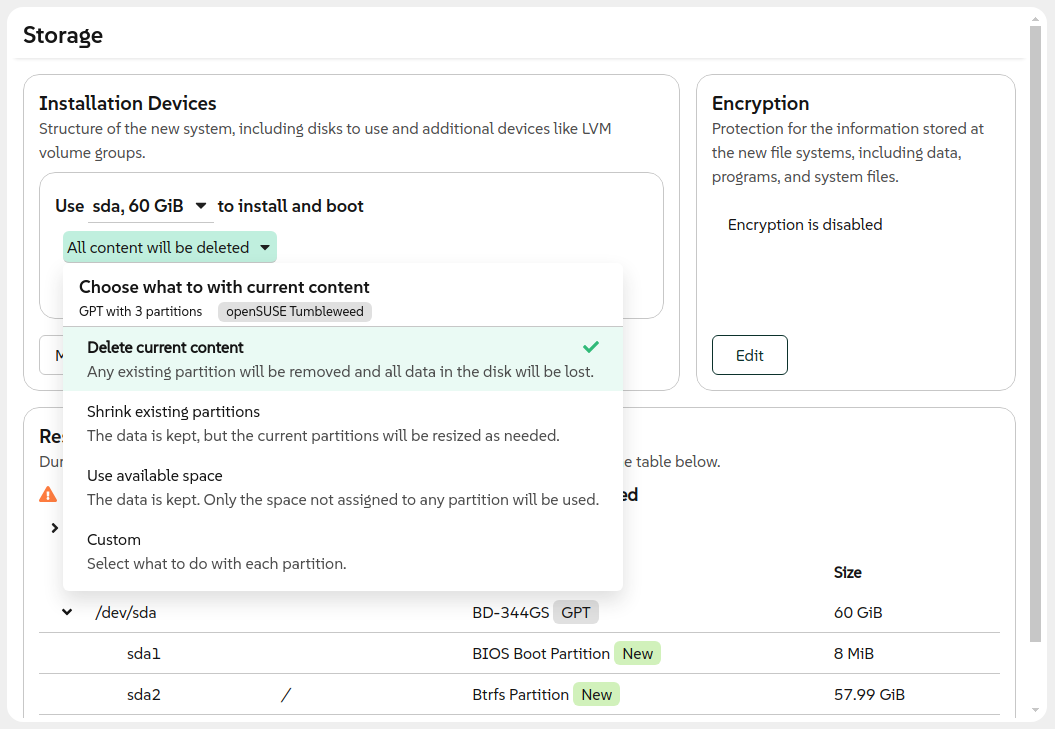
By manipulating the configuration it is possible to extend the installation over several disks and to reuse existing file systems, among many other things.
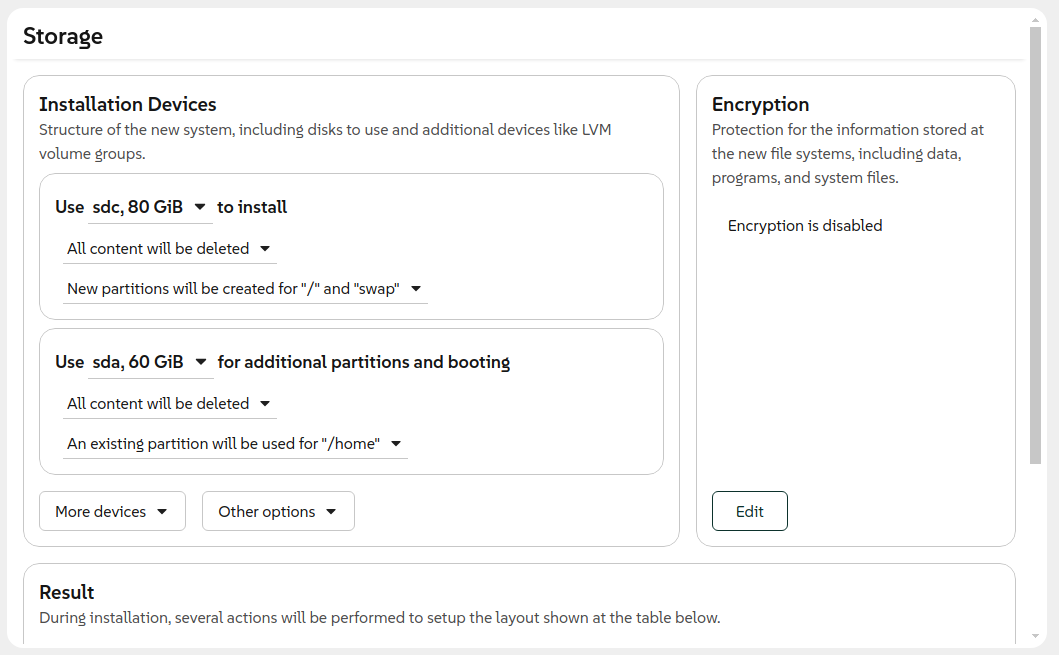
Usage of LVM
Adding new LVM volume groups is done using the same interface.
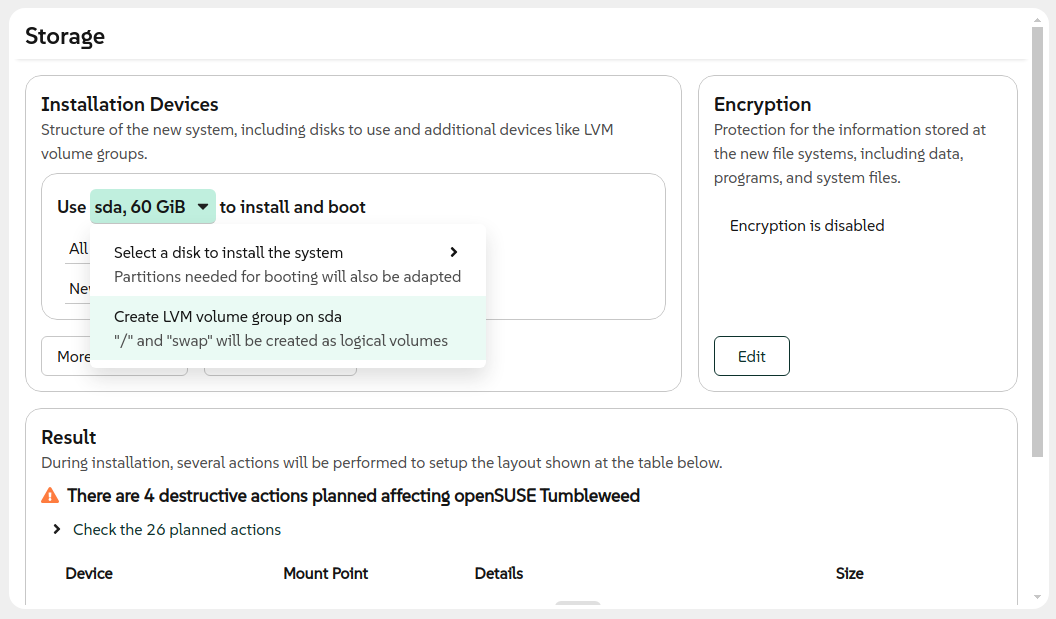
Obviously, the file systems created on an LVM volume group will be created as logical volumes analogous to the partitions of the disk case. Once again, it is possible to specify a loose configuration simply indicating the disk (or disks) that will be used by LVM and Agama calculates any partition that would be needed as physical volume, taking into account all the size overheads and roundings introduced by the different technologies like LVM or the used partition table type.
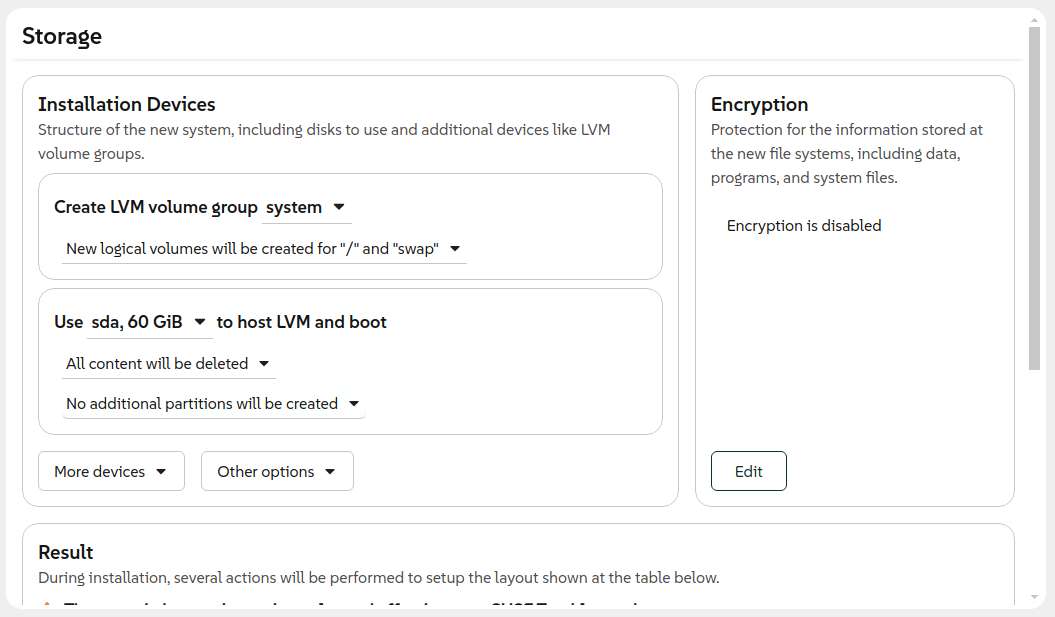
The disks in which the LVM is set are also visible as part of the configuration, so it is possible to tweak aspects like what to do with existing partitions or to define which disk will be used to create the additional partitions needed for booting.
Configuration of partitions needed for booting
One of the main features of the Agama storage setup is its ability to automatically determine any extra partition that may be needed for booting the new system, like PReP, EFI, Zipl or any other described at the corresponding YaST document. The algorithm can create those partitions or reuse existing ones that are already in the system if the user wants to keep them. The behavior of that feature can be tweaked using the corresponding entry at the advanced options menu.
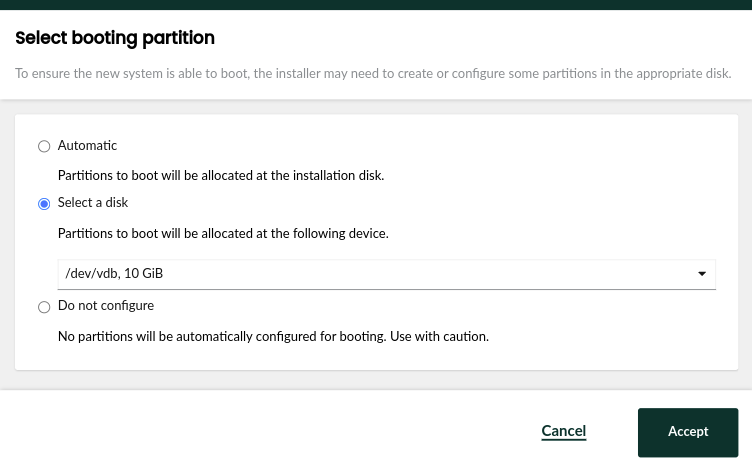
A note about transactional systems
Agama is able to install transactional distributions like openSUSE MicroOS. There will be no option at the Agama configuration to set whether the root file system of the installed system should be transactional (also known as "immutable") or not. Since the implications go beyond the file system settings, the nature of the system (transactional vs read-write) will be determined by the selection of the product (ie. the operating system) to install.
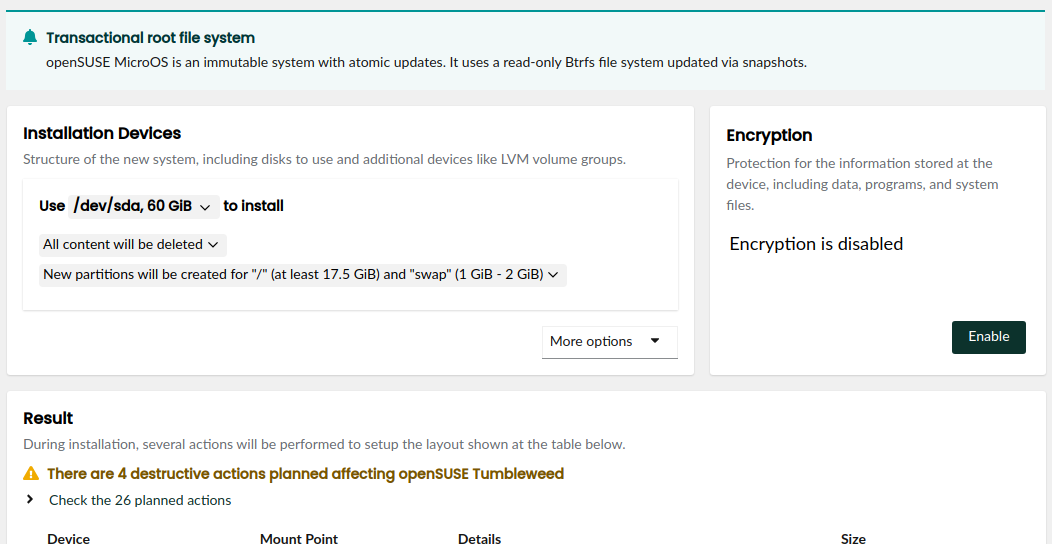
The initial proposal
Defining the file systems is essential for installing the system, so Agama always makes an attempt with an initial configuration before the user has had any opportunity to specify the settings (in an interactive installation) or if the user has omitted the storage configuration (in an unattended installation).
The current logic to calculate those default settings is intentionally simplistic - just trying to install into a single disk with the default product strategy to find space (eg. wiping the content of the disk) and using the other default sizes and settings of the product (eg. Btrfs snapshots). If that first attempt fails to calculate a valid storage setup and the system contains several disks, Agama will try again with the same settings on another disk. Up to a total of five attempts on as many different disks.
That is an important difference with YaST, which tries really hard to find a configuration that makes the installation possible even if that implies completely modifying the default settings (eg. going for minimal sizes, disabling Btrfs snapshots and removing separate partitions) in addition to trying different disks (or even combinations of disks).
The goal of the Agama approach is to provide a more consistent experience that makes the user part of the decision making process and aware of the changes introduced at the configuration. Adding some automatic adjustments for some clearly visible settings is not fully discarded for the future, subject to finding the right way to make those automatic decisions obvious to the users.